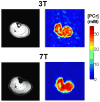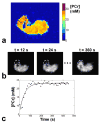3D-mapping of phosphocreatine concentration in the human calf muscle at 7 T: comparison to 3 T
- PMID: 23390003
- PMCID: PMC3657590
- DOI: 10.1002/mrm.24616
3D-mapping of phosphocreatine concentration in the human calf muscle at 7 T: comparison to 3 T
Abstract
Purpose: The development and implementation of a spectrally selective 3D-Turbo Spin Echo sequence for quantitative mapping of phosphocreatine (PCr) concentration in different muscles of the lower leg of healthy volunteers both at 3 T and 7 T.
Methods: Nine healthy volunteers were recruited, all of whom where scanned at 3 T and 7 T. Three dimensional PCr concentration maps were obtained after images were corrected for B1 inhomogeneities, T1 relaxation weighting, and partial volume of fatty tissue in the muscles. Two volunteers performed plantar flexions inside the magnet, and the oxidative capacity of their muscles was estimated.
Results: Three dimensional PCr concentration maps were obtained, with full muscle coverage and nominal voxel size of 0.52 mL at both fields. At 7 T a 2.7-fold increase of signal-to-noise ratio was achieved compared to 3 T.
Conclusion: Imaging (31) P metabolites at 7 T allowed for significant increase in signal to noise ratio compared to imaging at 3 T, while quantification of the PCr concentration remained unaffected. The importance of such an increase in signal-to-noise ratio is 2-fold, first higher resolution images with reduced partial volume effects can be acquired, and second multiple measurements such as dynamic imaging of PCr post-exercise, (31) P magnetization transfer, or other (1) H measurements, can be acquired in a single imaging session.
Keywords: 31P imaging; TSE imaging; calf muscle; high field 31P-MRI; phosphocreatine.
Copyright © 2013 Wiley Periodicals, Inc.
Figures






Similar articles
-
Spectrally selective 3D TSE imaging of phosphocreatine in the human calf muscle at 3 T.Magn Reson Med. 2013 Mar 1;69(3):812-7. doi: 10.1002/mrm.24288. Epub 2012 Apr 12. Magn Reson Med. 2013. PMID: 22499078 Free PMC article.
-
Rapid 3D-imaging of phosphocreatine recovery kinetics in the human lower leg muscles with compressed sensing.Magn Reson Med. 2012 Dec;68(6):1738-46. doi: 10.1002/mrm.24484. Epub 2012 Sep 28. Magn Reson Med. 2012. PMID: 23023624 Free PMC article.
-
Dynamic three-dimensional imaging of phosphocreatine recovery kinetics in the human lower leg muscles at 3T and 7T: a preliminary study.NMR Biomed. 2013 Mar;26(3):348-56. doi: 10.1002/nbm.2866. Epub 2012 Oct 13. NMR Biomed. 2013. PMID: 23065754 Free PMC article.
-
Dynamic phosphocreatine imaging with unlocalized pH assessment of the human lower leg muscle following exercise at 3T.Magn Reson Med. 2018 Feb;79(2):974-980. doi: 10.1002/mrm.26728. Epub 2017 May 30. Magn Reson Med. 2018. PMID: 28560829 Free PMC article.
-
Absolute quantification of phosphorus metabolite concentrations in human muscle in vivo by 31P MRS: a quantitative review.NMR Biomed. 2007 Oct;20(6):555-65. doi: 10.1002/nbm.1192. NMR Biomed. 2007. PMID: 17628042 Review.
Cited by
-
A nested phosphorus and proton coil array for brain magnetic resonance imaging and spectroscopy.Neuroimage. 2016 Jan 1;124(Pt A):602-611. doi: 10.1016/j.neuroimage.2015.08.066. Epub 2015 Sep 13. Neuroimage. 2016. PMID: 26375209 Free PMC article.
-
Magnetic Resonance Imaging of Phosphocreatine and Determination of BOLD Kinetics in Lower Extremity Muscles using a Dual-Frequency Coil Array.Sci Rep. 2016 Jul 28;6:30568. doi: 10.1038/srep30568. Sci Rep. 2016. PMID: 27465636 Free PMC article.
-
3D 31 P MR spectroscopic imaging of the human brain at 3 T with a 31 P receive array: An assessment of 1 H decoupling, T1 relaxation times, 1 H-31 P nuclear Overhauser effects and NAD.NMR Biomed. 2021 May;34(5):e4169. doi: 10.1002/nbm.4169. Epub 2019 Sep 13. NMR Biomed. 2021. PMID: 31518036 Free PMC article.
-
Compartment-based reconstruction of 3D acquisition-weighted 31 P cardiac magnetic resonance spectroscopic imaging at 7 T: A reproducibility study.NMR Biomed. 2023 Apr 12;36(9):e4950. doi: 10.1002/nbm.4950. Online ahead of print. NMR Biomed. 2023. PMID: 37046414 Free PMC article.
-
Improved phosphorus MRSI acquisition through compressed sensing acceleration combined with low-rank reconstruction.MAGMA. 2025 Apr;38(2):161-173. doi: 10.1007/s10334-024-01218-y. Epub 2024 Dec 27. MAGMA. 2025. PMID: 39729226 Free PMC article.
References
-
- Bottomley PA, Charles HC, Roemer PB, Flamig D, Engeseth H, Edelstein WA, Mueller OM. Human invivo phosphate metabolite imaging with 31P NMR. Magn Reson Med. 1988;7(3):319–336. - PubMed
Publication types
MeSH terms
Substances
Grants and funding
LinkOut - more resources
Full Text Sources
Other Literature Sources
Medical

